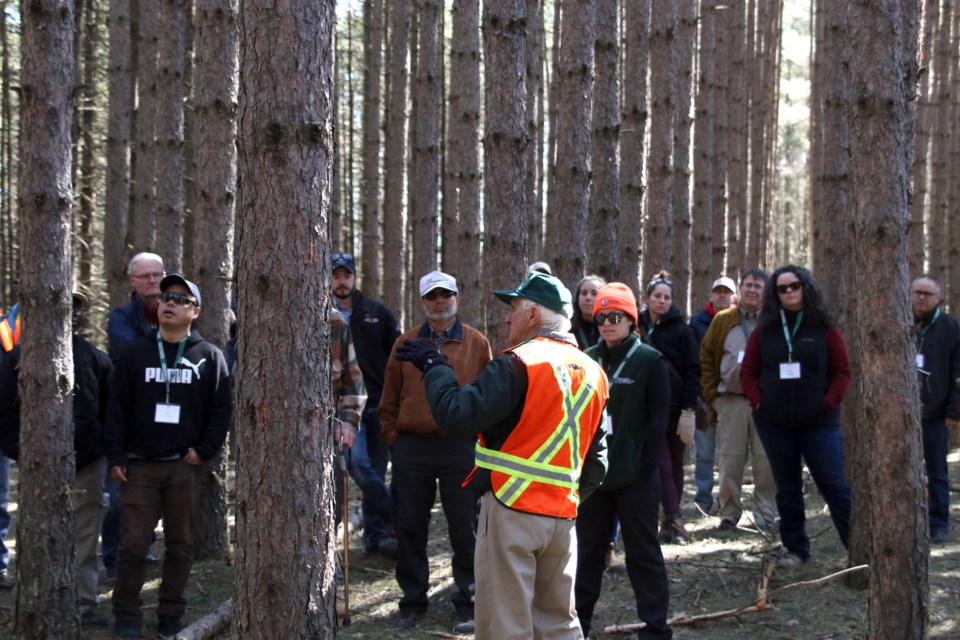THUNDER BAY - The ways to manage forests is just as diverse as the vegetation within and foresters from across the province are gathering in Thunder Bay to discuss how to address competing objectives by getting out into the woods and seeing plans and planting in action.
“We’re foresters. As much as we are tied to computers most days, we like to be in the woods,” said Chris Stratton, a forest productivity science specialist with the Ministry of Natural Resources and Forestry biodiversity monitoring unit.
“Most of us get into these careers for that type of experience, so the more we can get out of the office and out of a board room and actually walk around in the woods.”
The Ontario Professional Foresters Association is hosting its 2019 conference and general meeting in Thunder Bay this week, which included a tour of the Ministry of Natural Resources and Forestry Spacing Trial at the Natural Resource Centre on the 25th Side Road.
More than 125 foresters from across the province registered for the conference and the theme this year is the realities of foresters managing competition objectives.
“I don’t know if they are competing objectives or just more and more with public opinion involved in our forest management planning process, we have to juggle so many objectives, from what the public perceives as good and bad forestry, to wildlife objectives, ecology, to trying to keep our mills running so we have an industry and jobs for people,” Stratton said. “That’s all part of what we try to tie together in the demonstrations we have here.”
“Our whole theme was based on a young forester graduating from university, working in the field,” added Glen Swant, chair of the conference committee and former chief forester for the Buchanan Group. “We wanted all of these topics to be relevant to that person. The theme is realities of challenges for foresters today.”
The topics that will be discussed include legislation, certifications, forestry and mining, as well as at-risk species, which according to Swant is one of the biggest challenges facing forest management today.
Swant used the example of the woodland caribou that prefers mature Jack Pine forests as opposed to clear cut areas, which is a prime hunting ground for wolves.
“That is a major reality and challenge for every forester managing forests, regardless of where it is in Northern Ontario,” he said. “Because species at-risk are taking away large areas we would normally harvest in, we are trying to convince companies, governments, foresters to manage intensively like this so you produce more volume on an acre than you would in a natural forest.”
Foresters were given the opportunity to learn more about these kinds of management plans during a tour of the spacing trials at the Natural Resources Centre.
Stratton, who was one of the experts leading the tour, said there are a variety of demonstrations on the property, including spacing trials and genetic provenance trials, which show the effects of various forest management concepts in practice.
Seeing these practices in person sparked a lot of dialogue and discussion amongst the participants during the tour.
“Some of the dialogue we’ve had from the participants was phenomenal,” Stratton said. “It’s about shared understanding and shared knowledge and seeing some the effects of some of our principles and rules of thumb in practice. Figuring out what works and what doesn’t.”
Luke Klages, who recently graduated from the forestry program at Lakehead University and is now pursuing a master’s degree, said these kinds of tours are important for those working in forest management.
“I think it’s important to get out in the field so you don’t become too disconnected from what actually goes on in the field,” he said. “I think it’s easy to be in a planning position and spend most of your time in the office and not get out enough and not see the reality on the ground.”
But the reality on the ground and the perceptions in the wider public can be two very different things. Klages believes climate change is going to be one of the biggest challenges facing future forest management plans.
“I think public outreach will be a big part of that,” he said. “I think there is a lot of work that needs to be done there and informing the public.”
“Most people who live in the suburbs of Toronto don’t want to cut a tree and harvesting is an important part of re-growing a forest,” Swant added. “As a forest becomes old and decadent, it should be cut down, and then we replant.”
“But it’s hard for someone who is not familiar with the northern forest to accept that. We are trying hard through all of our organizations to convince people that forestry is a good thing.”
The conference continues on Wednesday and Thursday at the Delta Marriott Hotel.
